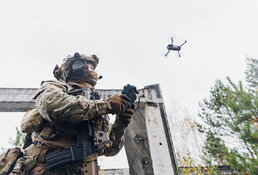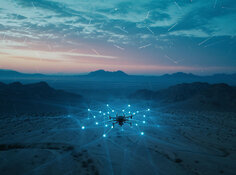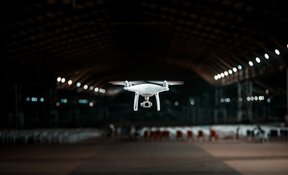DroneShield Ltd. (DRO:ASX; DRSHF:OTC) plans to expand both its manufacturing and its research and development (R&D) capacity significantly, reported the company in a newsletter release and Bell Potter Analyst Daniel Laing in a July 13 research flash.
"This is a positive development for DroneShield and one that reflects the high level of demand for the company's counterdrone (C-UAS) technology," Laing wrote.
For one, the Australian C-UAS company is developing a brand new 3,000-square-meter production facility in Alexandria, an inner southern suburb of Sydney, to include in-house production, testing, and warehousing. The total investment, including initial costs, such as leasing, plus buildout, is about AU$13 million (AU$13M). The expansion is expected to be completed in December 2025.
"It marks the company's largest facility to date — more than triple the size of its current production floor," wrote Proactive Investors Analyst Jonathan Jackson in a July 14 report.
Also, DroneShield will convert the current 2,500-square-meter production area at its Sydney headquarters into engineering and laboratory space, taking the company's total R&D capacity to 5,530 square meters.
"The investment supports DroneShield's ambitions to capture a share of its AU$2.34 billion (AU$2.34B) global sales pipeline, with Europe identified as the fastest-growing export market," Jackson wrote.
Once the new manufacturing plant is finished, the company expects to boost its annual production capacity to AU$900M by mid-2026 and its total manufacturing capacity to AU$2.4B by the end of 2026.
DroneShield's expansion news came at the same time that President of France Emmanuel Macron announced a doubling of the country's military spending to €64B by 2027, three years earlier than originally planned, reported Jackson.
Key Player in C-UAS Space
DroneShield is a defense manufacturer providing C-UAS solutions to customers globally, with a focus on radiofrequency sensing, artificial intelligence and machine learning, sensor fusion, electronic warfare, rapid prototyping and MIL-SPEC manufacturing. The company is one of the key players in the global anti-drone space, noted Market and Markets in its June 2025 report.
The company offers artificial intelligence (AI)-powered hardware and software solutions designed to detect, track and defeat unmanned threats from drones used by terrorists, state actors, criminals and other nefarious groups, according to its website. DroneShield has nine hardware products in its portfolio, two of which it introduced in Q1/25, notes its June 2025 Investor Presentation. The company's technology is safe and not destructive, posing no harm to drones or humans.
DroneShield is the only publicly listed company exclusively in the fast-growing C-UAS sector. As it continues growing, DroneShield is ideally positioned to drive innovation and deliver lasting value. It boasts 234 world-class engineers on its team and an annual R&D spend of AU$50M-plus.
Because the number of applications for DroneShield's C-UAS technology is on the rise, there is a significant opportunity to expand into multiple end markets. These include government facilities, energy production and critical Infrastructure, airports, military, correctional facilities, law enforcement, and other (stadiums, events, oil refineries, shipping and ports, etc.).
DroneShield continues executing on its extensive and growing pipeline, consisting of 268 projects and worth AU$2.41B, as of last month.
The company had a significant cash balance of AU$198.1M in cash, as of June 20, providing flexibility and supporting ongoing investment.
Robust Sector Growth Ahead
The global anti-drone market is forecasted to reach US$14.51B in value by 2030 from US$4.48B in 2025, reflecting a compound annual growth rate (CAGR) of 26.5%, according to Market and Markets.
The primary market growth driver is escalating security concerns about "unauthorized and potentially malicious use of drones" in military, critical infrastructure and public spaces, the report noted. Advances in detection and mitigation technologies, such as AI-powered systems, multisensor integration and directed energy weapons, in large part are fueling the market by improving the effectiveness and reliability of C-UAS solutions.
The ground-based segment is projected to hold the biggest share of the anti-drone market in 2030 due to the equipment's versatility, ease of deployment and ability to cover vast areas with integrated sensor arrays, noted Market and Markets.
The counterdrone arena also falls under the air defense system market, encompassing systems designed to detect, track, and engage aircraft, missiles, and drones, thereby providing layered defense capabilities, according to a July 2025 report by Research and Markets. This market is expected to expand at a 7.2% CAGR between 2025 and 2034.
"The market is characterized by continuous technological advancements, driven by evolving threats and the need for enhanced performance," noted Research and Markets. "The sector is advancing with technologies like AI and quantum computing to enhance drone defense and system resilience in areas like North America, Asia-Pacific, and beyond."
Australia and its allies around the world are bolstering their defense budgets and increasing their focus on counterdrone technologies, which likely means more business for DroneShield.
"We are stepping up to meet this demand by investing in state-of-the-art facilities here and abroad, and in sovereign Australian skills development to provide the most modern and effective counterdrone capabilities in the world," DroneShield Chief Executive Officer Oleg Vornik told Proactive Investor. "Our new facility in Alexandria will epitomize the value Australian engineering can bring to a changing geopolitical landscape."
For instance, the Australian Defence Force's (ADF) counter small uncrewed aerial systems project, LAND 156, is seeking and will select a systems integration partner that can deliver a command and control system that can spot and identify hostile drones, reported Gregor Ferguson for The Australian on June 16. The system must work with various sensors, guns, electronic jammers and directed energy weapons like high-energy lasers that can disable or destroy unfriendly drones cheaply. DroneShield is a contender, noted Ferguson.
In the U.S., the Army recently announced it will create a joint interagency task force dedicated to tackling drone threats, reported Mark Pomerleau for DefenseScoop on July 2. Servicemembers need better control of the skies and a more cost-effective approach to defeating large numbers of inexpensive drones.
"We need an organization that is joint, interagency has authorities, a colorless pot of money, and the authorities to go after requirements all the way through acquisition in a rapid way to be able to keep pace with that," General James Mingus, Army vice chief of staff, said during a recent event.
Countering drones requires numerous solutions, including long, short, and close in, and solutions at every level, Mingus said. Strategies must be easily and quickly adaptable to address new unmanned aircraft system (UAS) threats and advancing UAS technologies.
"We've got to have both the authority and then the funding flexibility to be able to switch to whatever that solution is going to be for the next year," Mingus added.
Pomerleau noted that in the Army's budget request this year, it added "a new agile line for C-UAS, along with UAS and electronic warfare."
The ReArm Europe Plan, now called Readiness 2030, aims to boost European Union (EU) defense spending to €800B (AU$1.4 trillion) by 2030, through fiscal flexibility and loans, reinforcing industrial and procurement autonomy throughout the EU and mobilizing private investment and support for Ukraine.
At the annual conference of the North Atlantic Treaty Organization (NATO) in late June, each of the members agreed to increase their own defense spending to 5% of their country's economic output from 2%, by 2035, reported The Washington Post on June 25.
Even before the NATO meeting, some countries already had planned to bolster their defense spending. In the U.S., the Trump Administration's proposed fiscal year 2026 (FY26) budget included a 13.4% increase in defense spending to US$1.01 trillion, reported the International Institute for Strategic Studies in May.
The Catalysts: Varied Growth
In its Investor Presentation, DroneShield listed its strategic growth priorities for 2025 and 2026, any of which could catalyze its share price. They are to:
1) Launch next generation hardware for all of its product families
2) Grow its software-as-a-service revenue through both new products as well as fresh options on existing products
3) Expand wallet share by embedding more solutions to customers
4) Develop a European manufacturing and regional sales hub facility
5) Begin selling its products to civilians
Two Buy Recommendations
Bell Potter's Laing, in his early July flash, reiterated his Buy recommendation and target price on DroneShield, but its share price already surged right past the latter. The analyst pointed out that using contract manufacturers in its supply chain allows DroneShield to expand its manufacturing capacity quickly. Also, it is a lower-cost, less risky way of establishing such capabilities in Europe and the U.S.
Laing, in his June 25 research report, described his outlook on DRO as positive. He wrote, "[We] are comfortable with the current valuation based on 1) forecast earnings growth, 2) increasing scale/frequency of contracts, 3) industry tailwinds and 4) strong reratings across the defense sector."
 Streetwise Ownership Overview*
Streetwise Ownership Overview*
DroneShield Ltd. (DRO:ASX; DRSHF:OTC)
Shaw and Partners Analyst Abraham Akra also rates DroneShield Buy, as noted in his research report on June 25. Since then, the counterdrone manufacturer reached and then surpassed Akra's target price on it.
Ownership and Share Structure
Vanguard Group has become a substantial shareholder in DroneShield, holding a 5.45% stake. Regal Funds Management holds approximately 7.15%, while State Street Global Advisors Australia Ltd. owns 4.12%. As for recent filings, Fidelity has 6.61%.
These holdings add to the company's strategic investors, which currently control over 11% of DroneShield's stock. Management and insiders hold 5.68%, according to the most recent company presentation.
DroneShield has 874.62 million outstanding shares and 755.23 million free float traded shares. Its market cap is approximately AU$2.34 billion, and its sales pipeline has grown to AU$2.3 billion. The company’s 52-week share price range is AU$0.59 to 2.72.
| Want to be the first to know about interesting Technology investment ideas? Sign up to receive the FREE Streetwise Reports' newsletter. | Subscribe |
Important Disclosures:
- As of the date of this article, officers and/or employees of Streetwise Reports LLC (including members of their household) own securities of DroneShield Ltd.
- Doresa Banning wrote this article for Streetwise Reports LLC and provides services to Streetwise Reports as an independent contractor.
- This article does not constitute investment advice and is not a solicitation for any investment. Streetwise Reports does not render general or specific investment advice and the information on Streetwise Reports should not be considered a recommendation to buy or sell any security. Each reader is encouraged to consult with his or her personal financial adviser and perform their own comprehensive investment research. By opening this page, each reader accepts and agrees to Streetwise Reports' terms of use and full legal disclaimer. Streetwise Reports does not endorse or recommend the business, products, services or securities of any company.
For additional disclosures, please click here.







































